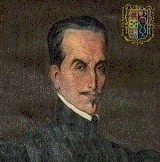
Peruvian literature
Encyclopedia
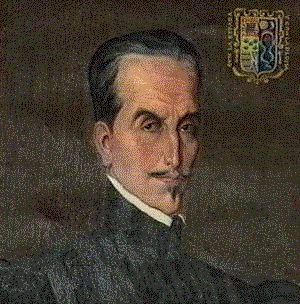
Peru
Peru , officially the Republic of Peru , is a country in western South America. It is bordered on the north by Ecuador and Colombia, on the east by Brazil, on the southeast by Bolivia, on the south by Chile, and on the west by the Pacific Ocean....
, but also to literature produced in the Viceroyalty of Peru
Viceroyalty of Peru
Created in 1542, the Viceroyalty of Peru was a Spanish colonial administrative district that originally contained most of Spanish-ruled South America, governed from the capital of Lima...
during the country's colonial period, and to oral
Oral tradition
Oral tradition and oral lore is cultural material and traditions transmitted orally from one generation to another. The messages or testimony are verbally transmitted in speech or song and may take the form, for example, of folktales, sayings, ballads, songs, or chants...
artistic forms created by diverse ethnic groups that existed in the area during the prehispanic period, such as the Quechua, the Aymara and the Chanka indigenous groups.
Prehispanic oral tradition
The artistic production of the pre-Hispanic period, especially art produced under the Incan Empire, is largely unknown. Literature produced in the central-Andean regionAndes
The Andes is the world's longest continental mountain range. It is a continual range of highlands along the western coast of South America. This range is about long, about to wide , and of an average height of about .Along its length, the Andes is split into several ranges, which are separated...
of modern-day Ecuador, Perú, Bolivia and Chile, was transmitted orally, as there were no known writing systems at the time. It consisted of two main poetic forms: harawis (from the Quechua language)--- a form of lyrical poetry---and hayllis--- a form of epic poetry. Both forms described the daily life and rituals of the time, and were recited by a poet known as the harawec.
Orally transmitted folktales expressed the cosmology of the Andean world, and included creation and destruction myths. Many of these stories have survived until the present, thanks in no small part to the efforts of early chroniclers such as Inca Garcilaso, who rediscovered Quechua poetry, and Guamán Poma de Ayala, who preserved mythology. Their inclusion in the "official canon" was a slow process, as they were not viewed with seriousness. For instance, Jose de la Riva Agüero
José de la Riva-Agüero y Osma
José de la Riva-Agüero y Osma was a Peruvian historian, writer and politician who served as Prime Minister of Peru...
, in his 1905 thesis Character of the Literature of Independent Peru considered the Pre-Hispanic literary tradition "insufficient" and unimportant in the formation of any new literary tradition. It was resurrected from obscurity in the 20th century, by a number of literary scholars and anthropologists who compiled and rescued Pre-Hispanic myths and legends. Among them are:
- Adolfo Vienrich - 'Tarmap Pacha Huaray (translated as 'Azucenas quechuas or Quechuan lilies), compiled in 1905; and Tarmapap Pachahuarainin (translated as Fabulas Quechuas or Quechuan fables), compiled in 1906
- Jorge BasadreJorge BasadreJorge Basadre Grohmann was a Peruvian historian known for his extensive publications about the independent history of his country...
- 'La literatura inca (Incan Literature), 1938; En torno a la literatura quechua (Regarding Quechua Literature), 1939. - José Maráa Arguedas, who translated a 17th century manuscript entitledHombres y dioses de Huarochirí(Men and Gods of Huarochiri)
- Martin Lienhard - 'La voz y su huella. Escritura y conflicto étnico-cultural en América Latina. 1492-1988 (The Voice and its Influence: Scripture and Ethnocultural Conflict in Latin America. 1492-1988) 1992
- Antonio Cornejo Polar -'Escribir en el aire: ensayo sobre la heterogeneidad socio-cultural en las literaturas andinas (To Write in the Air: An Essay Concerning Socio-cultural Heterogeneity in Andean Literatures), 1994
- Edmundo Bendezú -'Literatura Quechua (Quechua Literature), 1980 and La otra literatura (The Other Literature), 1986
Bendezú affirms that Quechua oral tradition constitutes a marginal system opposed to the dominant Hispanicizing force. He speaks of a great tradition of "enormous textual mass" which was marginalized and sidelined by the Western scriptural system. Luis Alberto Sánchez, on the other hand, employed elements of the Pre-Hispanic tradition to illustrate his theory of a racially mixed "Creole" literature of both indigenous and Iberian parentage. To this end, he cited chronicles by authors such as Cieza, Betanzos and Garcilaso.
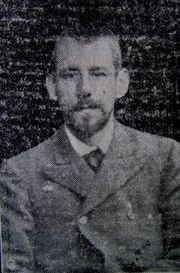
Literature of Peru's Discovery and Conquest
The Literature of Peru's discovery and conquest includes all works produced in the region during its discovery and conquest by Spain. It can also refer to literature produced roughly around this time. The period begins on November 15, 1532 in CajamarcaCajamarca
Cajamarca may refer to:Colombia*Cajamarca, Tolima a town and municipality in Tolima DepartmentPeru* Cajamarca, city in Peru.* Cajamarca District, district in the Cajamarca province.* Cajamarca Province, province in the Cajamarca region....
with the capture of the last Inca lord, Atahualpa
Atahualpa
Atahualpa, Atahuallpa, Atabalipa, or Atawallpa , was the last Sapa Inca or sovereign emperor of the Tahuantinsuyu, or the Inca Empire, prior to the Spanish conquest of Peru...
; it ends with the complete dismantling of the Incan Empire and the founding of the city of Lima
Lima
Lima is the capital and the largest city of Peru. It is located in the valleys of the Chillón, Rímac and Lurín rivers, in the central part of the country, on a desert coast overlooking the Pacific Ocean. Together with the seaport of Callao, it forms a contiguous urban area known as the Lima...
. The principal literary manifestations of this period are in the form of chronicle
Chronicle
Generally a chronicle is a historical account of facts and events ranged in chronological order, as in a time line. Typically, equal weight is given for historically important events and local events, the purpose being the recording of events that occurred, seen from the perspective of the...
s of discovery, or are epistolary in nature. Major works which explore the literature of this time include: Francisco Carrillo's Enciclopedia histórica de la literatura peruana (Historical Encyclopedia of Peruvian Literature), and various tomes by Raúl Porras Barrenechea which detail the works of the early chroniclers.
Spanish Chroniclers
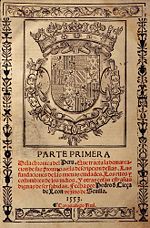
For the most part, these chroniclers all wrote from the perspective of the conqueror, whose mission was to "civilize" and "reveal the true faith" to the native peoples of Peru. Therefore, many of their descriptions and the motivations they ascribe to the indigenous peoples of the region are distorted and in error.
Among the official Spanish chroniclers were Francisco Xerez
Francisco Xerez
Francisco Xerez or Francisco de Jerez was a Spanish explorer-turned-historian, the personal secretary of conquistador Francisco Pizarro...
, personal secretary of Pizarro
Francisco Pizarro
Francisco Pizarro González, Marquess was a Spanish conquistador, conqueror of the Incan Empire, and founder of Lima, the modern-day capital of the Republic of Peru.-Early life:...
, who wrote the Verdadera relación de la conquista del Perú y provincia del Cuzco llamada la Nueva Castilla (The True Narrative of the Conquest of Peru and of Cuzco Province, Otherwise Known as New Castile), in 1531. He is also responsible for Relación Sámano-Xerez (the Samano-Xerez Narrative) of 1528, which details Pizarro's first expeditions of 1525 and 1527. His historical accounts are reiterated by Pedro Sancho de la Hoz, in his La Conquista de Peru (The Conquest of Peru), of 1524.
Another official Spanish chronicler was Fray Gaspar de Carvajal, who produced the Relacion del descubrimiento del famoso río grande de las Amazonas (The Narrative of the Discovery of the Famous Great River of the Amazons) of 1541–1542, which described the first expedition and cartography of the Peruvian amazon territory
Amazon Basin
The Amazon Basin is the part of South America drained by the Amazon River and its tributaries that drains an area of about , or roughly 40 percent of South America. The basin is located in the countries of Bolivia, Brazil, Colombia, Ecuador, Guyana, Peru, and Venezuela...
, and of its towns and indigenous inhabitants.
Other Spanish chroniclers worth mentioning are:
- Miguel de Estete - Noticia del Perú (News from Peru), 1535
- Cristobal de Molina — a Chilean who was the first to write of the Indigenous inhabitants of the region in hisRelación de muchas cosas acaesidas en el Perú, en suma para atender a la letra la manera que se tuvo la conquista y poblazon destos reinos... (Narrative of Many Events Taken Place in Peru, Aiming to Correctly Record its Conquest and Inhabitants), 1552
- Pedro Cieza de León -Crónica del Perú (Chronicle of Peru), published in 4 volumes: Parte primera de la Chrónica del Perú (First Volume of the Chronicle of Peru), 1550;El señorío de los Incas (The Lordship of the Incas), first published in 1873 but composed between 1548 and 1550; Descubrimiento y Conquista del Perú (The Discovery and Conquest of Peru), 1946; and the fourth volume, divided into five books: La guerra de las salinas (The Battle of the Salt Mines), La guerra de Chupas (The Battle of Chupas), La guerra de Quito (The Battle of Quito), La guerra de la Huarina (The Battle of Huarina) and La guerra de Jaquijaguana (The Battle of Jaquijaguan), published in 1877, 1881 and 1877 respectively.
Indigenous Chroniclers
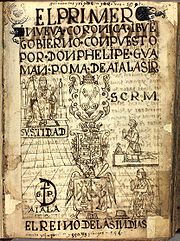
Felipe Guaman Poma de Ayala
Felipe Guaman Poma de Ayala , also known as Guamán Poma or Huamán Poma, was an indigenous Peruvian who became disillusioned with the treatment of the native peoples of the Andes by the Spanish after conquest...
's El primer nvueva corónica y bven govierno (First New Chronicle and Good Government) written between 1585 and 1615, but first published in 1936, in which the author details the devastation of the Andean world and tries to make sense of the chaotic reality in which the indigenous peoples find themselves. Juan de Santa Cruz Pachacuti also writes a chronicle in which he crudely attempts to explain the Inca cosmogony in rudimentary Spanish.
Guamán Poma, wrote an extensive 1179-page letter to the king of Spain, Philip III
Philip III of Spain
Philip III , also known as Philip the Pious, was the King of Spain and King of Portugal and the Algarves, where he ruled as Philip II , from 1598 until his death...
, in which he narrates the history of his universe and ends with a proposal for a utopic society. He embarks on a harsh criticism of the authorities, of the abusive priesthood, of the Spanish envoys and landed gentry, and of "mestizo" and creole society. In the words of Luis Alberto Sánchez
Luis Alberto Sánchez
Luis Alberto Félix Sánchez Sánchez was a Peruvian lawyer, jurist, philosopher, historian, and politician. A historic leader of the Partido Aprista Peruano, he became a Senator, President of the Senate, Vice President of the Republic and Prime Minister.His studies began in 1917...
, this long and futile letter constitutes an indictment of the colonial system.
Neoclassical Peruvian Literature
The hegemonyHegemony
Hegemony is an indirect form of imperial dominance in which the hegemon rules sub-ordinate states by the implied means of power rather than direct military force. In Ancient Greece , hegemony denoted the politico–military dominance of a city-state over other city-states...
of Creole oligarchy
Oligarchy
Oligarchy is a form of power structure in which power effectively rests with an elite class distinguished by royalty, wealth, family ties, commercial, and/or military legitimacy...
in Peruvian society favored the abandonment of indigenous forms in favor of European ones. Particularly successful among these were the imitation of Petrarch
Petrarch
Francesco Petrarca , known in English as Petrarch, was an Italian scholar, poet and one of the earliest humanists. Petrarch is often called the "Father of Humanism"...
and the use of Greek and Roman mythological allusions, as practiced by the Academia Antártica
Academia Antártica
The Academia Antártica was a society of writers, poets and intellectuals—mostly of the criollo caste—that assembled in Lima, Peru, in the 16th and 17th Centuries. Their objective was to author a body of literature that matched or surpassed that of Europe's and would prove that literariness indeed...
literary group in Lima
Lima
Lima is the capital and the largest city of Peru. It is located in the valleys of the Chillón, Rímac and Lurín rivers, in the central part of the country, on a desert coast overlooking the Pacific Ocean. Together with the seaport of Callao, it forms a contiguous urban area known as the Lima...
in the 16th and 17th Centuries. Early writers associated with the Academia include Francisco de Figueroa
Francisco de Figueroa
Francisco de Figueroa was a Spanish poet best known for his love sonnets and his bilingual compositions in Spanish and Italian...
, Diego Mexía de Fernangil, and the anonymous poetesses remembered only as "Clarinda"
Clarinda (poet)
Clarinda was the pen name used by an anonymous Peruvian poet, generally assumed to be a woman, who wrote in the early 17th Century. The only work attributed to her is the long poem Discourse in Praise of Poetry , which was printed in Seville in 1608. She is one of very few female, Spanish-speaking...
and "Amarilis". Later Neoclassicists
Neoclassicism
Neoclassicism is the name given to Western movements in the decorative and visual arts, literature, theatre, music, and architecture that draw inspiration from the "classical" art and culture of Ancient Greece or Ancient Rome...
, such as Manuel Asencio y Segura and Felipe Pardo y Aliaga, arose, too, and the genre dominated until the end of the 19th century.
19th-Century Literary Currents
The 19th-Century brought RomanticismRomanticism
Romanticism was an artistic, literary and intellectual movement that originated in the second half of the 18th century in Europe, and gained strength in reaction to the Industrial Revolution...
to Peru, with the works of Carlos Augusto Salaverry and José Arnaldo Márquez. Narrative prose developed away from the pastoral works of Manuel Ascensio Segura and Ricardo Palma
Ricardo Palma
Manuel Ricardo Palma Soriano was a Peruvian author, scholar, librarian and politician. His magnum opus is the Tradiciones peruanas.- Biography :...
) (see Costumbrismo) toward Modernism
Modernism
Modernism, in its broadest definition, is modern thought, character, or practice. More specifically, the term describes the modernist movement, its set of cultural tendencies and array of associated cultural movements, originally arising from wide-scale and far-reaching changes to Western society...
, with the works of Manuel González Prada
Manuel González Prada
Jose Manuel de los Reyes González de Prada y Ulloa was a Peruvian politician and anarchist, literary critic and director of the National Library of Peru...
and José Santos Chocano
José Santos Chocano
José Santos Chocano Gastañodi was a Peruvian poet who is also known as "The Singer of Americas", because the first line of one of his most celebrated poems: "I am the singer of the America, Autochthonous and Savage""...
.
Modernism in Peruvian Literature
The general crisis following the War of the PacificWar of the Pacific
The War of the Pacific took place in western South America from 1879 through 1883. Chile fought against Bolivia and Peru. Despite cooperation among the three nations in the war against Spain, disputes soon arose over the mineral-rich Peruvian provinces of Tarapaca, Tacna, and Arica, and the...
gave rise to Modernism
Modernism
Modernism, in its broadest definition, is modern thought, character, or practice. More specifically, the term describes the modernist movement, its set of cultural tendencies and array of associated cultural movements, originally arising from wide-scale and far-reaching changes to Western society...
in Peru. Its best-known exponents were José Santos Chocano
José Santos Chocano
José Santos Chocano Gastañodi was a Peruvian poet who is also known as "The Singer of Americas", because the first line of one of his most celebrated poems: "I am the singer of the America, Autochthonous and Savage""...
and José María Eguren
José María Eguren
José María Eguren Rodríguez was a Peruvian writer. Although principally known for his poetry, Eguren was also a journalist, painter, photographer and even an inventor....
.
The Avant-garde
Avant-garde
Avant-garde means "advance guard" or "vanguard". The adjective form is used in English to refer to people or works that are experimental or innovative, particularly with respect to art, culture, and politics....
movement was encouraged by the magazines Colónida and Amauta. Amauta was founded in 1926 by the prominent socialist essyainst José Carlos Mariátegui
José Carlos Mariátegui
José Carlos Mariátegui La Chira was a Peruvian journalist, political philosopher, and activist. A prolific writer before his early death at age 35, he is considered one of the most influential Latin American socialists of the 20th century...
. The influential poet César Vallejo
César Vallejo
César Abraham Vallejo Mendoza was a Peruvian poet. Although he published only three books of poetry during his lifetime, he is considered one of the great poetic innovators of the 20th century in any language. Thomas Merton called him "the greatest universal poet since Dante"...
was one of its collaborators. There were various splinter groups among the Avant-Gardist poets, whose major exponents were Xavier Abril
Xavier Abril
Xavier Abril de Vivero, was a Peruvian poet and essayist.-Bibliography:* Exposition de poèmes et designs, París, 1927* Various poems * Hollywood...
, Alberto Hidalgo, Sebastián Salazar Bondy
Sebastián Salazar Bondy
Sebastián Salazar Bondy was a Peruvian playwright, essayist, poet, and journalist, and among the most important of Peruvian intellectuals.- Publications :* Voz de vigilia * Cuadernos de la persona oscura...
and Carlos Germán Belli
Carlos Germán Belli
Carlos Germán Belli de La Torre is a Peruvian poet of Italian parentage. He won the Premio Iberoamericano de Poesía Pablo Neruda in 2006 which was awarded by the Consejo Nacional de la Cultura y las Artes de Chile...
.
Interest in indigenous poetry was resurrected by the work of Luis Fabio Xammar. Others who brought Indigenism
Indigenism
Indigenism, Native nationalism, or Indigenous nationalism is a kind of ethnic nationalism emphasizing the group's indigeneity to their homeland...
to the fore were Ciro Alegría
Ciro Alegría
Ciro Alegría Bazán was a Peruvian journalist, politician, and novelist.-Biography:Born in Huamachuco District, he exposed the problematic of the native Peruvians, learning about their way of life. This understanding of how they were oppressed was the focus for his novels...
, José María Arguedas
José María Arguedas
José María Arguedas Altamirano was a Peruvian novelist, poet, and anthropologist who wrote mainly in Spanish, although some of his poetry is in Quechua...
, and Manuel Scorza
Manuel Scorza
Manuel Scorza was an important Peruvian novelist, poet, and political activist, exiled under the regime of Manuel Odría. He was born in Lima....
.
During the 1950s urban realism developed with the works of Julio Ramón Ribeyro
Julio Ramón Ribeyro
Julio Ramón Ribeyro Zúñiga was a Peruvian writer best known for his short stories. He was also successful in other genres: novel, essay, theater, diary and aphorism. In the year of his death, he was awarded the US$100,000 Premio Juan Rulfo de literatura latinoamericana y del Caribe...
and the playwright Sebastián Salazar Bondy
Sebastián Salazar Bondy
Sebastián Salazar Bondy was a Peruvian playwright, essayist, poet, and journalist, and among the most important of Peruvian intellectuals.- Publications :* Voz de vigilia * Cuadernos de la persona oscura...
. Realism
Realism (arts)
Realism in the visual arts and literature refers to the general attempt to depict subjects "in accordance with secular, empirical rules", as they are considered to exist in third person objective reality, without embellishment or interpretation...
is also the province of the major luminary Mario Vargas Llosa
Mario Vargas Llosa
Jorge Mario Pedro Vargas Llosa, 1st Marquis of Vargas Llosa is a Peruvian-Spanish writer, politician, journalist, essayist, and Nobel Prize laureate. Vargas Llosa is one of Latin America's most significant novelists and essayists, and one of the leading authors of his generation...
, while Alfredo Bryce Echenique
Alfredo Bryce
Alfredo Bryce Echenique is a Peruvian-Spanish writer born in Lima. He has written several books and short stories.-Early days:...
incorporated new narrative
Narrative
A narrative is a constructive format that describes a sequence of non-fictional or fictional events. The word derives from the Latin verb narrare, "to recount", and is related to the adjective gnarus, "knowing" or "skilled"...
techniques within the genre.
Some of the most notable names in poetry
Poetry
Poetry is a form of literary art in which language is used for its aesthetic and evocative qualities in addition to, or in lieu of, its apparent meaning...
are Emilio Adolfo Westphalen, Jorge Eielson
Jorge Eielson
Jorge Eduardo Eielson was a Peruvian artist and writer. As an artist he is known for his quipus, a reinterpretation of an ancient Andean device, they are considered precursors of conceptual art....
, Carlos Germán Belli
Carlos Germán Belli
Carlos Germán Belli de La Torre is a Peruvian poet of Italian parentage. He won the Premio Iberoamericano de Poesía Pablo Neruda in 2006 which was awarded by the Consejo Nacional de la Cultura y las Artes de Chile...
, Antonio Cisneros
Antonio Cisneros
-Awards:*Premio Nacional de Poesía *Premio Casa de las Américas *Premio Rubén Darío *Condecoración al Mérito Cultural de la República de Hungría*Gabriela Mistral Inter-American Prize for Culture...
, Wáshington Delgado
Washington Delgado
José Washington Delgado Tresierra was a Peruvian poet.He studied at the Pontificia Universidad Católica del Perú in Lima, later pursuing his studies in literature in Madrid between 1955 and 1958....
, Marco Martos
Marco Martos Carrera
Marco Martos Carrera is a Peruvian poet and the President of the Academia Peruana de la Lengua. It's assumed from critics to be one of the most important persons of the Peruvian "60's generation". Critics also appoints that he uses a simple way of expression with an ironic way to project the life...
, Carmen Ollé.
Noteworthy in narrative
Narrative
A narrative is a constructive format that describes a sequence of non-fictional or fictional events. The word derives from the Latin verb narrare, "to recount", and is related to the adjective gnarus, "knowing" or "skilled"...
prose are: Miguel Gutiérrez
Miguel Gutiérrez
Miguel Gutiérrez is a Mexican football forward who played for Mexico in the 1958 FIFA World Cup. He also played for Club Atlas.-External links:*...
, Gregorio Martínez, Alonso Cueto
Alonso Cueto
Alonso Cueto Caballero is a Peruvian novelist and playwright. His novel El tigre blanco , published in 1985, was awarded the Premio Wiracocha. He has published regularly and currently writes for the newspaper Peru 21 and is a Professor of Journalism at the Catholic University of Peru...
and Guillermo Niño de Guzmán, among others.
Contemporary Peruvian Literature
Jaime BaylyJaime Bayly
Jaime Bayly Letts is a Peruvian writer, journalist and television personality. He is the third of 10 children and is known as "el niño terrible" .-Early life:...
is a noteworthy contemporary Peruvian writer. His work No se lo digas a nadie (Tell No One) has been adapted for the screen.
In the list of young writers we can highlight the work of Fernando Iwasaki, Ivan Thays, Oscar Malca, Peter Elmore, Enrique Planas, Diego Trelles-Paz, Carlos Yushimito
Carlos Yushimito
Carlos Yushimito del Valle is a Peruvian writer of Japanese descent.-Biography:Carlos Yushimito del Valle studied Latin American Literature at National University of San Marcos where he graduated in 2002...
, Santiago Roncagliolo
Santiago Roncagliolo
Santiago Rafael Roncagliolo Lohmann , is a Peruvian writer, scriptwriter, translator and journalist.- Life :Santiago Roncagliolo spent most of his childhood in the city of Arequipa...
and Daniel Alarcon
Daniel Alarcón
Daniel Alarcón is an author who lives in Oakland, California; he has been a the Distinguished Visiting Writer at Mills College and a Visiting Writer at California College of the Arts...
(finalist of PEN/Hemingway 2006 award). Also, it is relevant the work of new Peruvian poets as Jose Pancorvo, Jorge Eslava, Rossella di Paolo, Domingo de Ramos, Rocio Silva Santisteban, Doris Moromisato, Odi González, Ana Varela, Rodrigo Quijano, Jorge Frisancho, Gonzalo Portals, Rafael Espinosa, Lorenzo Helguero, Miguel Ildefonso, Selenco Vega, José Carlos Yrigoyen, Alberto Valdivia Baselli, Rubén Quiroz, among others.
Literature for children
Two seminal writers in the creation of children's literature in Peru are Francisco Izquierdo Ríos, the founder of Peruvian children's stories and Carlota Carvallo de Núñez. They both belong to the a post-Second World war generation and devoted themselves entirely to literature for children. Earlier authors had certainly occasionally written children's fables, stories and poetry, but only sporadically and as an annex to their main literary work. In children's poetry, without a doubt, Mario Florián was the most important poet creating an entire and beautiful tradition dedicated to the Peruvian children.
At the present time, among the many authors who write for Peruvian children are: Oscar Colchado Lucio, with his classic series of Andean adventures Cholito; Marcos Yauri Montero, with his "Risk of the fox", and Carlota Flores de Naveda, with her extraordinary work " Muki, the bull".
It is also necessary to note the Peruvian researchers into literature for children including: the historian [María Rostworowski] with" Peruvian Legends for children" a work which rescues the Incan children's literature; professor José Respaldiza Rojas extensive work Jitanjáforas, the only book which on this topic; the journalists and researcher brothers [J.y V. Ataucuri García], with Peruvian Fables, where they analyse more than fifty fables; the professor and song-writer Edgard Bendezú "Marko Polo", with his vast series Fabulinka, poems composed with an ingineous flavour; the researcher and poet Danilo Sánchez Lihón, the premier critic in the children's literature in Peruvian; professor and crictic Jesus Cabel; the poet Rosa Cerna; the former president of the APLIJ (Peruvian Association of Children and Juvenile Literature) Eduardo de la Cruz Yataco; the teacher and poet Ruth Barrios, Roberto Rosario and others.

